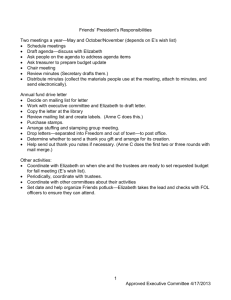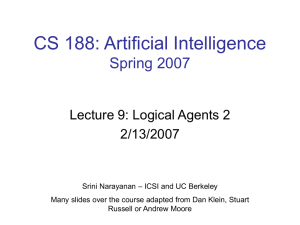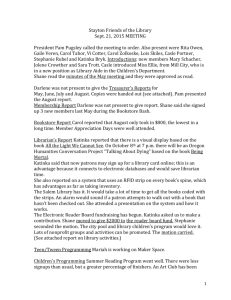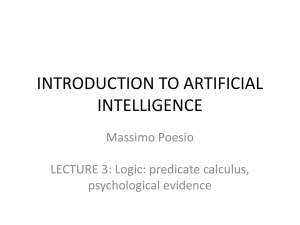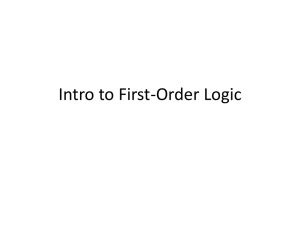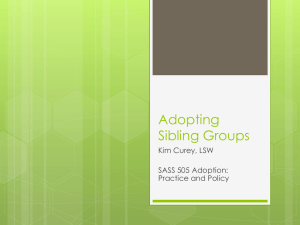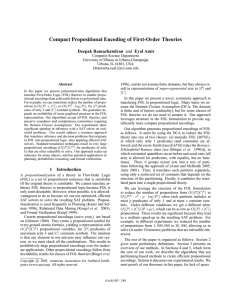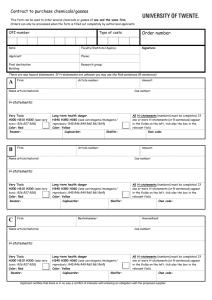Lec6 - WordPress.com
advertisement
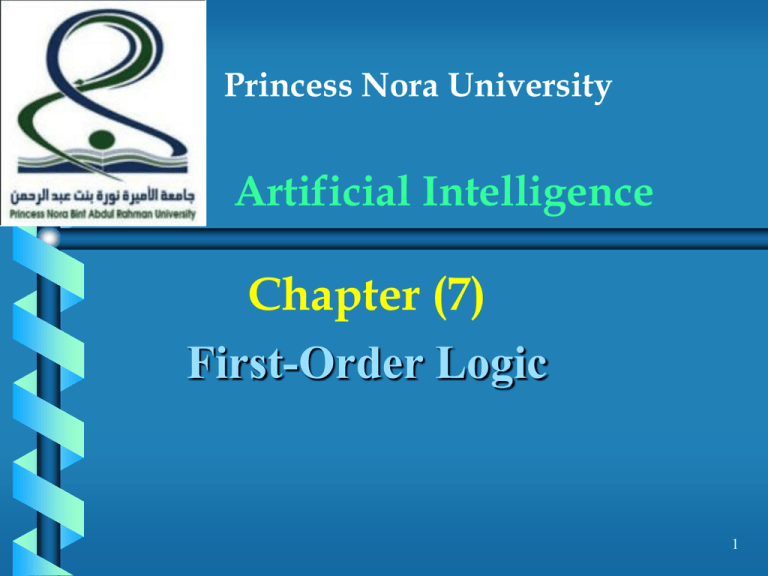
Princess Nora University
Artificial Intelligence
Chapter (7)
First-Order Logic
1
Outline
•
•
•
•
•
Why FOL?
Syntax and semantics of FOL
Using FOL
Wumpus world in FOL
Knowledge engineering in FOL
2
Pros and cons of propositional logic
•
•
Propositional logic is declarative
Propositional logic allows partial/disjunctive/negated
information
– (unlike most data structures and databases)
• Propositional logic is compositional:
– meaning of B1,1 P1,2 is derived from meaning of B1,1
and of P1,2
• Meaning in propositional logic is context-independent
– (unlike natural language, where meaning depends on
context)
• Propositional logic has very limited expressive power
– (unlike natural language)
3
First-order logic
• Whereas propositional logic assumes the
world contains facts,
• first-order logic (like natural language)
assumes the world contains
– Objects: people, houses, numbers, colors,
baseball games, wars, …
– Relations: red, round, prime, brother of, bigger
than, part of, comes between, …
– Functions: father of, best friend, one more
than, plus, …
4
Syntax of FOL: Basic elements
•
•
•
•
•
•
•
Constants
KingJohn, 2, NUS,...
Predicates
Brother, >,... (return true of false)
Functions
Sqrt, LeftLegOf,... (return value)
Variablesx, y, a, b,...
Connectives , , , ,
Equality
=
Quantifiers
,
5
Atomic sentences
Atomic sentence =
predicate (term1,...,termn)
or term1 = term2
Term
function (term1,...,termn)
or constant or variable
=
• E.g., Brother(KingJohn,RichardTheLionheart) >
(Length(LeftLegOf(Richard)),
Length(LeftLegOf(KingJohn)))
6
Complex sentences
• Complex sentences are made from atomic
sentences using connectives
S, S1 S2, S1 S2, S1 S2, S1 S2,
E.g. Sibling(KingJohn,Richard)
Sibling(Richard,KingJohn)
>(1,2) ≤ (1,2)
>(1,2) >(1,2)
7
Truth in first-order logic
• Sentences are true with respect to a model and an interpretation
• Model contains objects (domain elements) and relations among them
• Interpretation specifies referents for
constant symbols
→
objects
predicate symbols
→
relations
function symbols
→
functional relations
• An atomic sentence predicate(term1,...,termn) is true
iff the objects referred to by term1,...,termn
are in the relation referred to by predicate
8
Models for FOL: Example
9
Universal quantification
• <variables> <sentence>
Everyone at PNU is smart:
x At(x,PNU) Smart(x)
• x P is true in a model m iff P is true
with x being each possible object in the
model
10
A common mistake to avoid
• Typically, is the main connective with
• Common mistake: using as the main connective
with :
x At(x,PNU) Smart(x)
means “Everyone is at PNU and everyone is smart”
11
Existential quantification
• <variables> <sentence>
• Someone at PNU is smart:
• x At(x,PNU) Smart(x)
• x P is true in a model m iff P is true
with x being some possible object in
the model
12
Another common mistake to avoid
• Typically, is the main connective with
• Common mistake: using as the main connective
with :
x At(x,PNU) Smart(x)
is true if there is anyone who is not at PNU!
13
Properties of quantifiers
• x y is the same as y x
• x y is the same as y x
• x y is not the same as y x
• x y Loves(x,y)
– “There is a person who loves everyone in the world”
• y x Loves(x,y)
– “Everyone in the world is loved by at least one person”
• Quantifier duality: each can be expressed using the other
• x Likes(x,IceCream) x Likes(x,IceCream)
• x Likes(x,Broccoli)
x Likes(x,Broccoli)
14
Equality
• term1 = term2 is true under a given interpretation if
and only if term1 and term2 refer to the same object
• E.g., definition of Sibling in terms of Parent:
x,y Sibling(x,y) [(x = y) m,f (m = f)
Parent(m,x) Parent(f,x) Parent(m,y) Parent(f,y)]
15
Using FOL
The kinship domain:
Brothers are siblings
x,y Brother(x,y) Sibling(x,y)
• One's mother is one's female parent
m,c Mother(c) = m (Female(m) Parent(m,c))
• “Sibling” is symmetric
x,y Sibling(x,y) Sibling(y,x)
16
Interacting with FOL KBs
• Given a sentence S and a substitution σ,
• Sσ denotes the result of plugging σ into S; e.g.,
S = Smarter(x,y)
σ = {x/Hillary,y/Bill}
Sσ = Smarter(Hillary,Bill)
• Ask(KB,S) returns some/all σ such that KB╞ σ
17
Knowledge engineering in FOL
1. Identify the task
2. Assemble the relevant knowledge
3. Decide on a vocabulary of predicates, functions,
and constants
4. Encode general knowledge about the domain
5. Encode a description of the specific problem
instance
6. Pose queries to the inference procedure and get
answers
7. Debug the knowledge base
18
